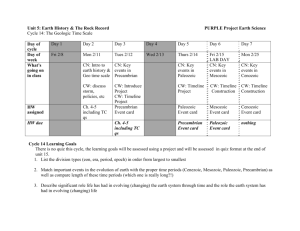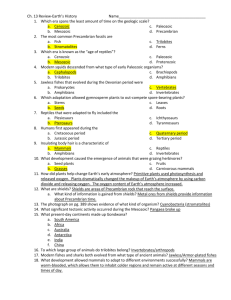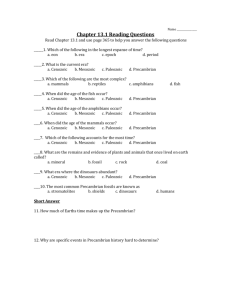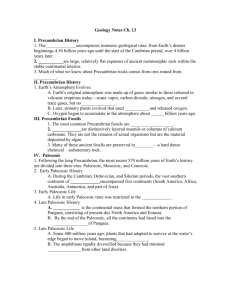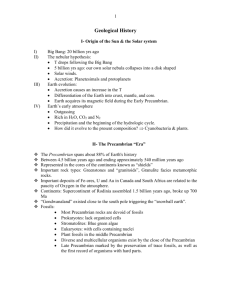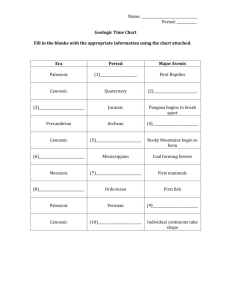Earth Science, 10th edition Chapter 11: Earth`s History I
advertisement
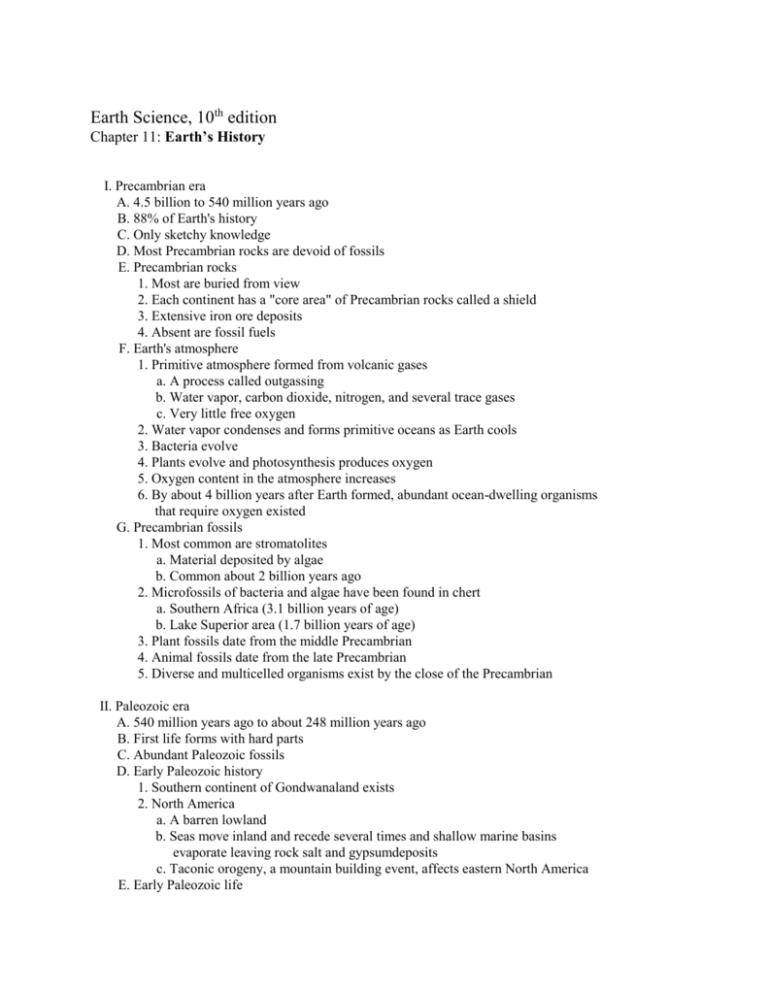
Earth Science, 10th edition Chapter 11: Earth’s History I. Precambrian era A. 4.5 billion to 540 million years ago B. 88% of Earth's history C. Only sketchy knowledge D. Most Precambrian rocks are devoid of fossils E. Precambrian rocks 1. Most are buried from view 2. Each continent has a "core area" of Precambrian rocks called a shield 3. Extensive iron ore deposits 4. Absent are fossil fuels F. Earth's atmosphere 1. Primitive atmosphere formed from volcanic gases a. A process called outgassing b. Water vapor, carbon dioxide, nitrogen, and several trace gases c. Very little free oxygen 2. Water vapor condenses and forms primitive oceans as Earth cools 3. Bacteria evolve 4. Plants evolve and photosynthesis produces oxygen 5. Oxygen content in the atmosphere increases 6. By about 4 billion years after Earth formed, abundant ocean-dwelling organisms that require oxygen existed G. Precambrian fossils 1. Most common are stromatolites a. Material deposited by algae b. Common about 2 billion years ago 2. Microfossils of bacteria and algae have been found in chert a. Southern Africa (3.1 billion years of age) b. Lake Superior area (1.7 billion years of age) 3. Plant fossils date from the middle Precambrian 4. Animal fossils date from the late Precambrian 5. Diverse and multicelled organisms exist by the close of the Precambrian II. Paleozoic era A. 540 million years ago to about 248 million years ago B. First life forms with hard parts C. Abundant Paleozoic fossils D. Early Paleozoic history 1. Southern continent of Gondwanaland exists 2. North America a. A barren lowland b. Seas move inland and recede several times and shallow marine basins evaporate leaving rock salt and gypsumdeposits c. Taconic orogeny, a mountain building event, affects eastern North America E. Early Paleozoic life 1. Restricted to seas 2. Vertebrates had not yet evolved 3. Life consisted of several invertebrate groups a. Trilobites b. Brachiopods c. Cephalopods 4. First organisms with hard parts, such as shells – perhaps for protection F. Late Paleozoic history 1. Supercontinent of Pangaea forms 2. Several mountain belts formed during the movements of the continents 3. World's climate becomes very seasonal, causing the dramatic extinction of many species G. Late Paleozoic life 1. Organisms diversified dramatically 2. Land plants 3. Fishes evolve into two groups of bony fish a. Lung fish b. Lobe-finned fish which become the amphibians 4. Insects invade the land 5. Amphibians diversify rapidly 6. Extensive coal swamps develop III. Mesozoic era A. 248 million years ago to about 65 million years ago B. Often called the "age of dinosaurs" C. Mesozoic history 1. Begins with much of the world's land above sea level 2. Seas invade western North America 3. Breakup of Pangaea begins forming the Atlantic ocean 4. North American plate began to override the Pacific plate 5. Mountains of western North America began forming D. Mesozoic life 1. Survivors of the great Paleozoic extinction 2. Gymnosperms become the dominant trees 3. Reptiles (first true terrestrial animals) readily adapt to the dry Mesozoic climate 4. Reptiles have shell-covered eggs that can be laid on the land 5. Dinosaurs dominate 6. One group of reptiles led to the birds 7. Many reptile groups, along with many other animal groups, become extinct at the close of the Mesozoic a. One hypothesis is that a large asteroid or comet struck Earth b. Another possibility is extensive volcanism IV. Cenozoic era A. 65 million years ago to the present B. Often called the "age of mammals" C. Smaller fraction of geologic time than either the Paleozoic or the Mesozoic D. North America 1. Most of the continent was above sea level throughout the Cenozoic era 2. Many events of mountain building, volcanism, and earthquakes in the West 3. Eastern North America a. Stable with abundant marine sedimentation b. Eroded Appalachians were raised by isostatic adjustments 4. Western North America a. Building of the Rocky Mountains was coming to an end b. Large region is uplifted 1. Basin and Range Province formed 2. Re-elevates the Rockies 3. Rivers erode and form gorges (e.g., Grand Canyon and Black Canyon) c. Volcanic activity is common 1. Fissure eruptions form the Columbia Plateau 2. Volcanoes form from northern California to the Canadian border d. Coast Ranges form e. Sierra Nevada become faultblock mountains E. Cenozoic life 1. Mammals replace reptiles as the dominant land animals 2. Angiosperms (flowering plants with covered seeds) dominate the plant world a. Strongly influenced the evolution of both birds and mammals b. Food source for both birds and mammals 3. Two groups of mammals evolve after the reptilian extinctions at the close of the Mesozoic a. Marsupials b. Placentals 4. Mammals diversify quite rapidly and some groups become very large a. e.g., Hornless rhinoceros, which stood nearly 16 feet high b. Many large animals became extinct 5. Humans evolve

